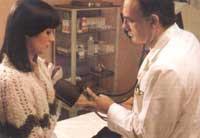Checks: insurance against all risk
1992/06/01 Agirre, Jabier - Medikua eta OEEko kidea Iturria: Elhuyar aldizkaria
Global and periodic medical recognitions are highly recommended for those who, because of the stress they suffer in their day to day, are exposed to certain diseases, such as executives. These studies do not allow to detect and measure stress, anxiety, depression and other psychological alterations, but are an unbeatable tool to improve their health, since they help the doctor to detect certain psychosomatic diseases as common as coronary, hypertension or ulcers. In this sense, we must not forget that in executives the most frequent cause of death is infarction.
Four are the basic tests for early detection of cardiovascular disease.
Stress test

The alleged sick (or able to get sick) must perform a staggered and controlled exercise by bike and/or traveling sole to increase circulatory and cardiac work. This test allows the doctor to measure the capacity or capacity and reserve of the system (in short of the heart) and its adaptation to exercise.
This test allows knowing with precision the limits and limitations that cause the gravity of a situation. For this reason, this test is especially suitable for the suspicion of coronary artery disease, since it allows to measure the coronary reserve, that is, it quantifies the severity of the narrowness of the arteries and, therefore, the reduction of the amount of blood that reaches the heart.
If the result of the stress test is negative, the check will be completed. In case of doubt, the exam should continue.
Test of the Talio
The thallium is a radioactive isotope that is left in the heart in direct proportion to the amount of blood that reaches the heart through the coronary arteries if injected through the patient's vein. If the thallium concentration in some areas (and more in the whole heart) is high, it indicates that the amount of blood that reaches the heart is adequate. On the contrary, if the concentration is weak or there are no talions in some areas, there is a warning that prevents blood from reaching the heart. This test usually coincides with the stress test and consists of “reading” the heart images of the thallium using a sophisticated device called gammacarmara.
If the thallium test is negative, you do not have to worry, but if it is dubious or positive, you will have to make a catheterization to the patient.
Cardiac catheterization and angiography
The most accurate and precise procedure to reach the diagnosis of coronary artery disease is to introduce a very fine catheter or tube through the veins and arteries of the fold of the elbow or thigh, in order to reach the heart and arteries.
Since the end of this catheter is attached to very sophisticated meters, it is possible to know its degree of effectiveness while the heart is working. As can be seen, this is a totally sophisticated technique that requires high-tech tools and hospitalization of the patient.

Along the catheter, a liquid substance can be injected that acts as a contrast, that is, it can oppose to X-rays the vessels and spindles of the heart and arteries. In this way, its interior is visible. The cardiologist, therefore, faces the heart and can see if the arteries are tight (and to what extent they are tight), if there is a risk of infarction or repetition, if the role of the heart muscle is normal… From that moment on, it will be decided whether medical treatment (with drugs) or surgical technique is necessary.
The main measure to be taken in the case of the other main executive disease (hypertension) is periodic control, since if it is not detected and treated on time, strokes can be produced, in addition to complicating heart and kidney conditions.
Measurement of tension
Periodically, the tension should be measured, listening to the blood pressure exerted through a manguita that tightens the arm and empties gradually.
To measure stress, the patient must be relaxed without any stress. If you can catch it in the morning and you have to repeat it, always at the same time. On the other hand, remember that the measure of tension after an intense exercise is not valid.
Specifically, the tension hose, also called a sphygmomanometer, consists of two parts or parts: a hose filled with air (equipped with a closing valve) and a pressure gauge sphere (usually graduated in millimeters of mercury). There are several types of sphygmomanometers: glued walls, automatic, manuals, etc.

It is important to know that the tension varies depending on the perimeter of the extremity in which the cuff is placed (the thicker the arm or leg, the more cuff will be necessary). They are usually up to 5 cm wide, usually rubber and should be chosen according to the weight and constitution of the person.
When going to another group of diseases, unfortunately gastrointestinal disorders do not control the symptoms that indicate their presence (pain, diarrhea, vomiting, etc.) until his appearance. Then you have to decide whether it is gastritis, ulcer, pancreatitis or doloride colon syndrome.
For this purpose, two tests are necessary: blood tests and stool tests. If the results are not complete, the patient should ingest a kind of papilla (contrast of magnesium or bismuth) and pass through X-rays the papilla to the ulcer through the digestive system or other lesions.
These tests can be done at any time, but some are annoying and costly, so it may be better to go to the specialist when the disorders last several hours or when they are repeated with relative frequency.
The Ten Commandments for a Healthy Executive (Decalogue)
- Maintain adequate weight
Infarctions of obesity, hypertension, increase of uric acid, etc. Facilitates or launches. - Feeding in a balanced way
The abuse of fats, fried, etc. fattened and is usually a way to increase cholesterol and uric acid.
Eat calm and chew well If not eaten like this, it can cause gastritis and stomach pain.- Prudence and logic is the substitution of
work meals by office meetings. - Perform
an annual medical checkup, that is, perform an exhaustive clinical examination. - Sleep at least 8 hours a day. It
is essential to recover the daily intellectual wear and tackle work problems by resting properly. - Enjoy regular holidays Getting
away and forgetting (although only for a few days) from everyday work problems and concerns are excellent ways to improve productivity and intellectual performance. - Having hobbies and that allows
them to distract themselves and enjoy leisure.
Perform physical exercise always attending to age and health conditions and performing exercises appropriate to them.
5.-

Gai honi buruzko eduki gehiago
Elhuyarrek garatutako teknologia





